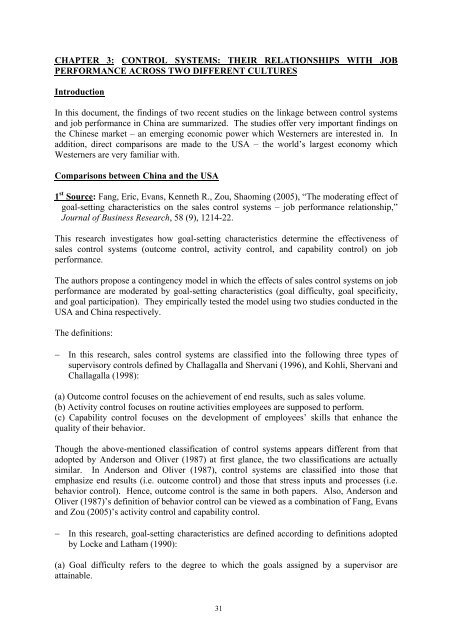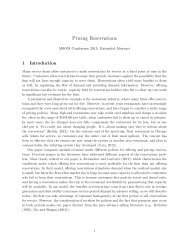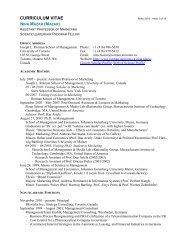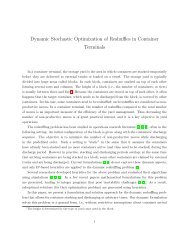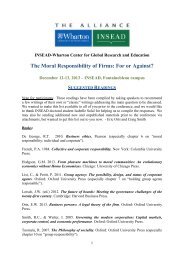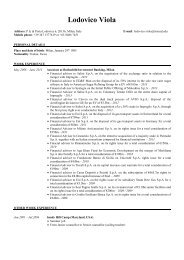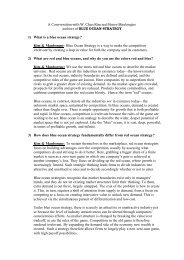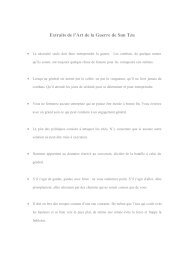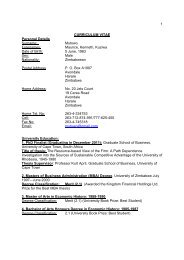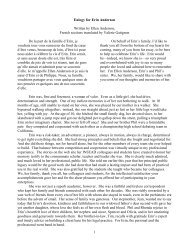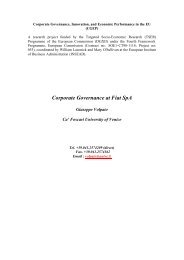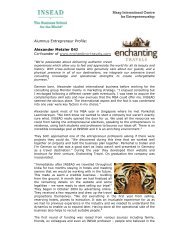Leading the Effective Sales Force: The Asian Sales Force ... - Insead
Leading the Effective Sales Force: The Asian Sales Force ... - Insead
Leading the Effective Sales Force: The Asian Sales Force ... - Insead
You also want an ePaper? Increase the reach of your titles
YUMPU automatically turns print PDFs into web optimized ePapers that Google loves.
CHAPTER 3: CONTROL SYSTEMS: THEIR RELATIONSHIPS WITH JOB<br />
PERFORMANCE ACROSS TWO DIFFERENT CULTURES<br />
Introduction<br />
In this document, <strong>the</strong> findings of two recent studies on <strong>the</strong> linkage between control systems<br />
and job performance in China are summarized. <strong>The</strong> studies offer very important findings on<br />
<strong>the</strong> Chinese market – an emerging economic power which Westerners are interested in. In<br />
addition, direct comparisons are made to <strong>the</strong> USA – <strong>the</strong> world’s largest economy which<br />
Westerners are very familiar with.<br />
Comparisons between China and <strong>the</strong> USA<br />
1 st Source: Fang, Eric, Evans, Kenneth R., Zou, Shaoming (2005), “<strong>The</strong> moderating effect of<br />
goal-setting characteristics on <strong>the</strong> sales control systems – job performance relationship,”<br />
Journal of Business Research, 58 (9), 1214-22.<br />
This research investigates how goal-setting characteristics determine <strong>the</strong> effectiveness of<br />
sales control systems (outcome control, activity control, and capability control) on job<br />
performance.<br />
<strong>The</strong> authors propose a contingency model in which <strong>the</strong> effects of sales control systems on job<br />
performance are moderated by goal-setting characteristics (goal difficulty, goal specificity,<br />
and goal participation). <strong>The</strong>y empirically tested <strong>the</strong> model using two studies conducted in <strong>the</strong><br />
USA and China respectively.<br />
<strong>The</strong> definitions:<br />
− In this research, sales control systems are classified into <strong>the</strong> following three types of<br />
supervisory controls defined by Challagalla and Shervani (1996), and Kohli, Shervani and<br />
Challagalla (1998):<br />
(a) Outcome control focuses on <strong>the</strong> achievement of end results, such as sales volume.<br />
(b) Activity control focuses on routine activities employees are supposed to perform.<br />
(c) Capability control focuses on <strong>the</strong> development of employees’ skills that enhance <strong>the</strong><br />
quality of <strong>the</strong>ir behavior.<br />
Though <strong>the</strong> above-mentioned classification of control systems appears different from that<br />
adopted by Anderson and Oliver (1987) at first glance, <strong>the</strong> two classifications are actually<br />
similar. In Anderson and Oliver (1987), control systems are classified into those that<br />
emphasize end results (i.e. outcome control) and those that stress inputs and processes (i.e.<br />
behavior control). Hence, outcome control is <strong>the</strong> same in both papers. Also, Anderson and<br />
Oliver (1987)’s definition of behavior control can be viewed as a combination of Fang, Evans<br />
and Zou (2005)’s activity control and capability control.<br />
− In this research, goal-setting characteristics are defined according to definitions adopted<br />
by Locke and Latham (1990):<br />
(a) Goal difficulty refers to <strong>the</strong> degree to which <strong>the</strong> goals assigned by a supervisor are<br />
attainable.<br />
31


